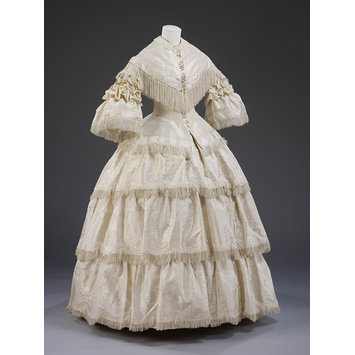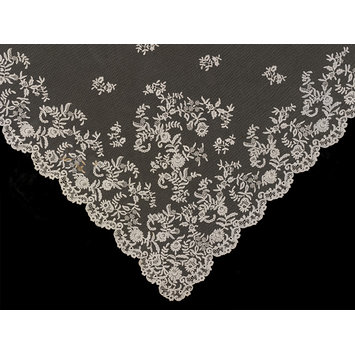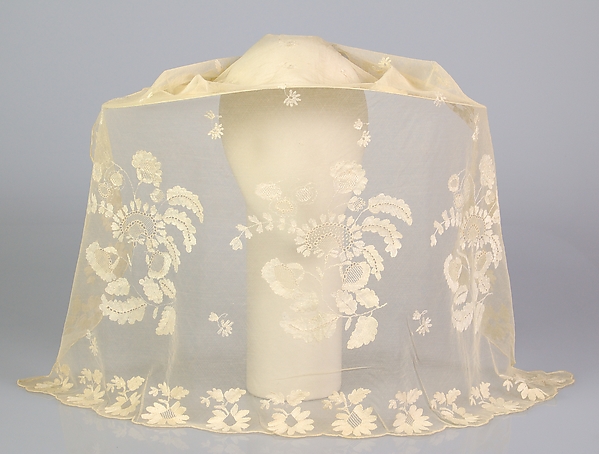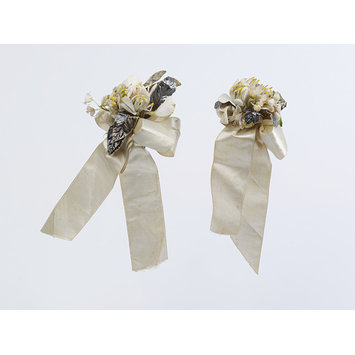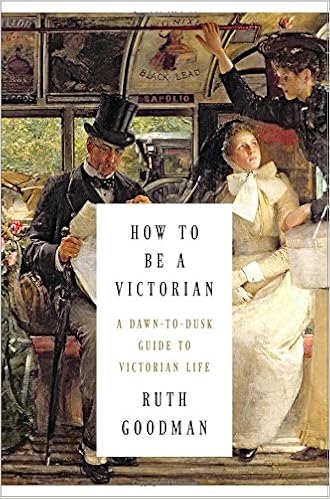In preparation for this year's Candlelight Tours (featuring the 1857 Huggins-Work Wedding), some background on 1850s weddings:
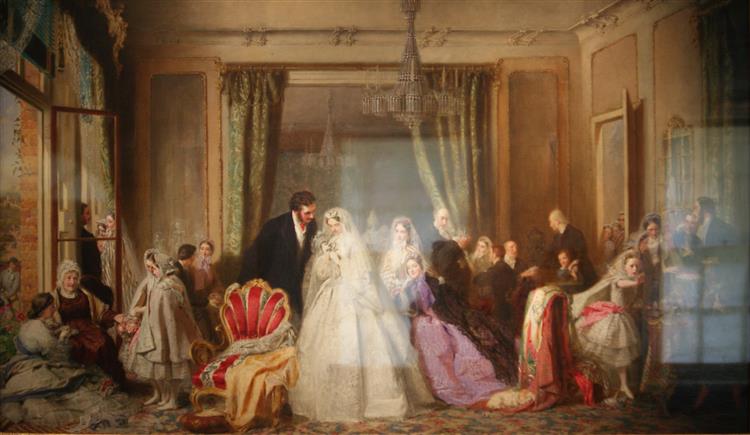 |
| George Elgar Hick's Changing Homes (1862). |
To quote extensively from The Etiquette of Courtship and Matrimony (London, 1852):
"The parties who must be asked, are the father and mother of the gentleman, the brothers and sisters (their wives and husbands also, if married), and the immediate relations and favoured friends of both parties. Old family friends on the bride's side should also receive invitations,-- the rationale, or original intention of this wedding assemblage, being to give publicity to the fact, that the bride is leaving her paternal home with the consent and approbation of her parents."
The bride's parents or guardians are omitted, as they are, in fact, hosting the event. Contrary to current practice, friends excluded from the reception on account of crowding are expected to put in an appearance at the church.
Aside from invitations, there are several customs which announce the wedding: wedding cake is sent to special friends, especially those too far away to attend the ceremony, and notices are put in the newspaper to inform the general public. When settled into their new home, the newlywed couple will send their (visiting) cards to all acquaintances they mean to keep.
Aside from invitations, there are several customs which announce the wedding: wedding cake is sent to special friends, especially those too far away to attend the ceremony, and notices are put in the newspaper to inform the general public. When settled into their new home, the newlywed couple will send their (visiting) cards to all acquaintances they mean to keep.
The Ceremony
There seem to be several possible period practices (page 356 of Inquire Within For Everything You Want to Know [1856] has a very succinct treatment of the subject):- Church wedding in the morning, followed by a wedding "breakfast" (reception) at the bride's parents' house which lasts into early afternoon; then the couple leave on their wedding trip
- Church wedding in the morning, from which the couple immediately leaves on their wedding trip
- Wedding before a magistrate ("a mere repetition of a vow")
- Wedding held in bride's family home (ceremony and reception both), which may take place in the evening
The actual descriptions read almost identical to modern practices, save that the bride is assumed to be wearing gloves and that the word "obey" is still used. For more details on British institutions (including banns, licenses, special licenses, etc.) see The Etiquette of Courtship...
Attendants
Sources agree that the number of bridesmaids can vary greatly: Godey's gives three as typical, but twelve or sixteen as possible; Bridal Etiquette suggests one to six, as the bride fancies. These may be close friends of the bride, or young relatives (10-14 years old) of either party. They are supposed to help the bride dress, receive guests, and hold her gloves/bouquet for her. According to custom, all bridesmaids stand to the bride's left during the wedding ceremony, and all groomsmen to the groom's right. Groomsmen may equal the number of bridesmaids, though in British custom, there's only one regardless of the number of ladies.
The Wedding Breakfast or Supper
" A wedding breakfast is a collation--kind of blending of all the repasts that are served up morning, noon, or night..."- Cassell's Illustrated Family Paper (1860)
"At a large party, or at a wedding, there is generally a supper table; lemonade and cakes having been sent round during the evening."-The Behavior Book (1854)
Mrs. Beeton's Book of Household Management (1861, mostly earlier material) gives a recommended Bill of Fare for a summer Wedding or Christening Breakfast, or a Ball Supper. The cake is placed in a place of prominence, toasts are proposed, and music/dancing is apparently out of fashion (or not, depending on the source).
Defunct Customs
A number of "exploded" bridal customs are named:- Displaying wedding badges on one's clothes or carriage when embarking on the wedding trip
- Throwing "an old shoe" at the bride
- Inviting too many guests for the available space
- Throwing the bride's stocking
- Visiting the bridal chamber.
- All guests kissing the bride.
- A bridesmaid accompanying the couple on their wedding trip
Wedding Presents
According to Mr. Thayer in Pastor's Wedding Gift, it is customary for the presiding clergyman to present a book of advice (and/or a thematic devotional work) to the newlyweds. Titles such as "The White Veil: A Bridal Gift" and "The Bridal Souvenir" are also advertised as good bridal presents.
Close friends and relatives may choose to present the bride with "plate, furniture, jewelry, and articles of adornment" for use in her new home (the story "Bridal Presents" mentions many utensils and dishes). Miss Leslie recommends "any handsome article of dress, or of furniture", also noting that articles of jewelry and household ornaments are customary. These presents from friends are distinct from the gifts of jewelry which her fiance may have presented, and from the trousseau (new clothing) given to the bride by her parents.
Though not everyone approves of the custom, bridal gifts are typically displayed, along with the giver's name.
Gifts may by homemade, such as these suggestions from Martha Pullen's Treasures in Needlework (1855):
Bridal Presents (To be worked in embroidery, braidwork, beads, or Berlin-work):Chairs, Sofa Cushions, Screens, Hand Screens, Antimacassars, Table Covers, Set of Dish Mats, Fancy Mats, Ottomans, Whatnots, Doyleys, Watchpockets, Netted Curtains
For A Bride: Point-Lace Collars, Chemisettes, Handkerchiefs, etc., Embroidered Ditto, Handkerchief Case or Box, Glove Box, Slippers, Work Basket, Carriage Bags, Purses, Porte-Monnaie or Note Case, Embroidered Aprons, Toilet (Pin) Cushions, Reticules
Bibliography (see also individual citations)
Beadle's Dime Book of Practical Etiquette. New York, 1859. Available here.
de Chatelaine, Clara. Bridal Etiquette. London, 1856. Available here.
Etiquette: Social Ethics and the Courtesies of Society. London, 1854. Available here.
Hartley, Cecil B. The Gentlemen's Book of Etiquette and Manual of Politeness. London, 1860. Available here.
Leslie, Eliza. The Behavior Book. Philadelphia, 1853. Available here.
The Etiquette of Courtship and Matrimony. London, 1852. Available here.
Thornwell, Emily. The Lady's Guide to Perfect Gentility. New York, 1856. Available here.
Willis, Henry. Etiquette and the Usages of Society. New York, 1860. Available here.


